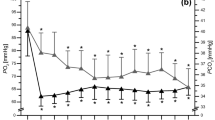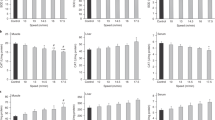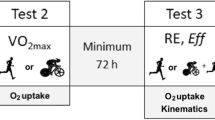Abstract
Objective:
The aim was to investigate the effects of acute exercise under hypoxic condition and the repetition of such exercise in a ‘living low-training high’ training on the antioxidant/prooxidant balance.
Design:
Randomized, repeated measures design.
Setting:
Faculté de Médecine, Clermont-Ferrand, France.
Subjects:
Fourteen runners were randomly divided into two groups. A 6-week endurance training protocol integrated two running sessions per week at the second ventilatory threshold into the usual training.
Intervention:
A 6-week endurance training protocol integrated two running sessions per week at the second ventilatory threshold into the usual training. The first hypoxic group (HG, n=8) carried out these sessions under hypoxia (3000 m simulated altitude) and the second normoxic group (NG, n=6) in normoxia. In control period, the runners were submitted to two incremental cycling tests performed in normoxia and under hypoxia (simulated altitude of 3000 m). Plasma levels of advanced oxidation protein products (AOPP), malondialdehydes (MDA) and lipid oxidizability, ferric-reducing antioxidant power (FRAP), lipid-soluble antioxidants (α-tocopherol and β-carotene) normalized for triacyglycerols and cholesterol were measured before and after the two incremental tests and at rest before and after training.
Results:
No significant changes of MDA and AOPP level were observed after normoxic exercise, whereas hypoxic exercise induced a 56% rise of MDA and a 44% rise of AOPP. Plasma level of MDA and arterial oxygen hemoglobin desaturations after the acute both exercises were highly correlated (r=0.73). α-Tocopherol normalized for cholesterol and triacyglycerols increased only after hypoxic exercise (10–12%, P<0.01). After training, FRAP resting values (−21%, P<0.05) and α-tocopherol/triacyglycerols ratio (−24%, P<0.05) were diminished for HG, whereas NG values remained unchanged.
Conclusions:
Intense exercise and hypoxia exposure may have a cumulative effect on oxidative stress. As a consequence, the repetition of such exercise characterizing the ‘living low-training high’ model has weakened the antioxidant capacities of the athletes.
Sponsorship:
International Olympic Committee and the Direction Régionale de la Jeunesse et des Sports de la Région Auvergne.
This is a preview of subscription content, access via your institution
Access options
Subscribe to this journal
Receive 12 print issues and online access
$259.00 per year
only $21.58 per issue
Buy this article
- Purchase on Springer Link
- Instant access to full article PDF
Prices may be subject to local taxes which are calculated during checkout




Similar content being viewed by others
References
Alessio HM (1993). Exercise-induced oxidative stress. Med Sci Sports Exerc 25, 218–224.
Askew EW (2002). Work at high altitude and oxidative stress: antioxidant nutrients. Toxicology 180, 107–119.
Bailey DM, Davies B, Romer L, Castell L, Newsholme E, Gandy G (1998). Implications of moderate altitude training for sea-level endurance in elite distance runners. Eur J Appl Physiol Occup Physiol 78, 360–368.
Bailey DM, Davies B, Young IS (2001b). Intermittent hypoxic training: implications for lipid peroxidation induced by acute normoxic exercise in active men. Clin Sci (London) 101, 465–475.
Bailey DM, Davies B, Young IS, Hullin DA, Seddon PS (2001a). A potential role for free radical-mediated skeletal muscle soreness in the pathophysiology of acute mountain sickness. Aviat Space Environ Med 72, 513–521.
Benzie IF, Strain JJ (1996). The ferric reducing ability of plasma (FRAP) as a measure of ‘antioxidant power’: the FRAP assay. Anal Biochem 239, 70–76.
Burke LM, Slater G, Broad EM, Haukka J, Modulon S, Hopkins WG (2003). Eating patterns and meal frequency of elite Australian athletes. Int J Sport Nutr Exerc Metab 13, 521–538.
Chao WH, Askew EW, Roberts DE, Wood SM, Perkins JB (1999). Oxidative stress in humans during work at moderate altitude. J Nutr 129, 2009–2012.
Clarkson PM, Thompson HS (2000). Antioxidants: what role do they play in physical activity and health? Am J Clin Nutr 72 (2 Suppl), 637–646.
Dernbach AR, Sherman WM, Simonsen JC, Flowers KM, Lamb DR (1993). No evidence of oxidant stress during high-intensity rowing training. J Appl Physiol 74, 2140–2145.
Di Massimo C, Scarpelli P, Penco M, Tozzi-Ciancarelli MG (2004). Possible involvement of plasma antioxidant defences in training-associated decrease of platelet responsiveness in humans. Eur J Appl Physiol 91, 406–412.
Dill DB, Costill DL (1974). Calculation of percentage changes in volumes of blood, plasma, and red cells in dehydration. J Appl Physiol 37, 247–248.
Emonson DL, Aminuddin AH, Wight RL, Scroop GC, Gore CJ (1997). Training-induced increases in sea level VO2max and endurance are not enhanced by acute hypobaric exposure. Eur J Appl Physiol Occup Physiol 76, 8–12.
Hitka P, Vizek M, Wilhelm J (2003). Hypoxia and reoxygenation increase H2O2 production in rats. Exp Lung Res 29, 585–592.
Jefferson JA, Simoni J, Escudero E, Hurtado ME, Swenson ER, Wesson DE et al. (2004). Increased oxidative stress following acute and chronic high altitude exposure. High Alt Med Biol 5, 61–69.
Ji LL (1996). Exercise, oxidative stress, and antioxidants. Am J Sports Med 24, S20–24.
Joanny P, Steinberg J, Robach P, Richalet JP, Gortan C, Gardette B et al. (2001). Operation everest III (Comex'97): the effect of simulated sever hypobaric hypoxia on lipid peroxidation and antioxidant defence systems in human blood at rest and after maximal exercise. Resuscitation 49, 307–314.
Kanter MM (1994). Free radicals, exercise, and antioxidant supplementation. Int J Sport Nutr 4, 205–220.
Kawai Y, Iwane H, Takanami Y, Shimomitsu T, Katsumura T, Fujinami J (1994). Vitamin E is mobilized in relation to lipolysis after strenuous endurance exercise. Med Sci Sports Exerc 26, S27.
Kehrer JP, Lund LG (1994). Cellular reducing equivalents and oxidative stress. Free Radical Biol Med 17, 65–75.
Levine BD, Stray-Gundersen J (1992). A practical approach to altitude training: where to live and train for optimal performance enhancement. Int J Sports Med 13, S209–S212.
Levine BD, Stray-Gundersen J, Duhaime G, Schell PG, Friedman DB (1991). ‘Living high-training low’: the effect of altitude acclimatization/normoxic training in trained runners. Med Sci Sports Exerc 23, S25.
Lyan B, Azais-Braesco V, Cardinault N, Tyssandier V, Borel P, Alexandre-Gouabau MC et al. (2001). Simple metho for clinical determination of 13 carotenoids in human plasma using an isocratic high-performance liquid chromatographic method. J Chromatogr B Biomed Sci Appl 751, 297–303.
Margaritis I, Tessier F, Richard MJ, Marconnet P (1997). No evidence of oxidative stress after a triathlon race in highly trained competitors. Int J Sports Med 18, 186–190.
Mazzeo RS, Child A, Butterfield GE, Mawson JT, Zamudio S, Moore LG (1998). Catecholamine response during 12 days of high-altitude exposure (4300 m) in women. J Appl Physiol 84, 1151–1157.
Miyazaki H, Oh-ishi S, Ookawara T, Kizaki T, Toshinai K, Ha S et al. (2001). Strenuous endurance training in humans reduces oxidative stress following exhausting exercise. Eur J Appl Physiol 84, 1–6.
Mohanraj P, Merola AJ, Wright VP, Clanton TL (1998). Antioxidants protect rat diaphragmatic muscle function under hypoxic conditions. J Appl Physiol 84, 1960–1966.
Moller P, Loft S, Lundby C, Olsen NV (2001). Acute hypoxia and hypoxic exercise induce DNA strand breaks and oxidative DNA damage in humans. FASEB J 15, 1181–1186.
Moran M, Delgado J, Gonzalez B, Manso R, Megias A (2004). Responses of rat myocardial antioxidant defences and heat shock protein. HSP72 induced by 12 and 24-week treadmill training. Acta Physiol Scand 180, 157–166.
Ohkawa H, Ohishi N, Yagi K (1979). Assay for lipid peroxides in animal tissues by thiobarbituric acid reaction. Anal Biochem 95, 351–358.
Ohno H, Yahata T, Sato Y, Yamamura K, Taniguchi N (1988). Physical training and fasting erythrocyte activities of free radical scavenging enzyme systems in sedentary men. Eur J Appl Physiol Occup Physiol 57, 173–176.
Pincemail J, Deby C, Camus G, Pirnay F, Bouchez R, Massaux L et al. (1988). Tocopherol mobilization during intensive exercise. Eur J Appl Physiol Occup Physiol 57, 189–191.
Radak Z, Ogonovszky H, Dubecz J, Pavlik G, Sasvari M, Pucsok J et al. (2003). Super-marathon race increases serum and urinary nitrotyrosine and carbonyl levels. Eur J Clin Invest 33, 726–730.
Rayssiguier Y, Gueux E, Bussiere L, Mazur A (1993). Copper deficiency increases the susceptibility of lipoproteins and tissues to peroxidation in rats. J Nutr 123, 1343–1348.
Robertson JD, Maughan RJ, Duthie GG, Morrice PC (1991). Increased blood antioxidant systems of runners in response to training load. Clin Sci (London) 80, 611–618.
Sen CK (1995). Oxidants and antioxidants in exercise. J Appl Physiol 79, 675–686.
Sen CK (2001). Antioxidants in exercise nutrition. Sports Med 31, 891–908.
Sen CK, Khanna S, Reznick AZ, Roy S, Packer L (1997). Glutathione regulation of tumor necrosis factor-alpha-induced NF-kappa B activation in skeletal muscle-derived L6 cells. Biochem Biophys Res Commun 28, 645–649.
Simon-Schnass I (1996). Oxidative stress at high altitude and effects of vitamin E. In: Marriott BM, Carlson SJ (eds). Nutritional Needs in Cold and in High Altitude Environments. National Academy Press: Washington DC, pp 393–418.
Subudhi AW, Davis SL, Kipp RW, Askew EW (2001). Antioxidant status and oxidative stress in elite alpine ski racers. Int J Sport Nutr Exerc Metab 1, 32–41.
Toskulkao C, Glinsukon T (1996). Endurance exercise and muscle damage: relationship to lipid peroxidation and scavenging enzymes in short and long distance runners. Jpn Phys Fitness Sports Med 46, 63–70.
Vasankari TJ, Kujala UM, Rusko H, Sarna S, Ahotupa M (1997). The effect of endurance exercise at moderate altitude on serum lipid peroxidation and antioxidative functions in humans. Eur J Appl Physiol Occup Physiol 75, 396–399.
Wasserman K (1987). Determinants and detection of anaerobic threshold and consequences of exercise above it. Circulation 76, VI29–VI39.
Wing SL, Askew EW, Luetkemeier MJ, Ryujin DT, Kamimori GH, Grissom CK (2003). Lack of effect of Rhodiola or oxygenated water supplementation on hypoxemia and oxidative stress. Wilderness Environ Med 14, 9–16.
Winklhofer-Roob BM, Khoschsorur G, Meinitzer A, Maritschnegg M, Hiller D; Wuga S, Wonisch W et al. (2003). Effects of vitamin E depletion/repletion on vitamin E status and oxidative stress in healthy volunteers. Clin Nutr 22, S33.
Witko-Sarsat V, Friedlander M, Capeillere-Blandin C, Nguyen-Khoa T, Nguyen AT, Zingraff J et al. (1996). Advanced oxidation protein products as a novel marker of oxidative stress in uremia. Kidney Int 49, 1304–1313.
Yagi K (1992). Lipids peroxides and exercise. Med Sport Sci 37, 40–42.
Acknowledgements
We thank the subjects for their contribution. We also thank Eric Clottes for reviewing the manuscript and Clark Ellice and English review of the manuscript.
This study was funded by the ‘International Olympic Committee’ and the ‘Direction Régionale de la Jeunesse et des Sports de la Région Auvergne’.
Author information
Authors and Affiliations
Corresponding author
Rights and permissions
About this article
Cite this article
Pialoux, V., Mounier, R., Ponsot, E. et al. Effects of exercise and training in hypoxia on antioxidant/pro-oxidant balance. Eur J Clin Nutr 60, 1345–1354 (2006). https://doi.org/10.1038/sj.ejcn.1602462
Received:
Revised:
Accepted:
Published:
Issue Date:
DOI: https://doi.org/10.1038/sj.ejcn.1602462
Keywords
This article is cited by
-
Changes in blood rheological properties and biochemical markers after participation in the XTERRA Poland triathlon competition
Scientific Reports (2022)
-
Impaired redox homeostasis in the heart left ventricles of aged rats experiencing fast-developing severe hypobaric hypoxia
Biogerontology (2019)
-
Three weeks of intermittent hypoxic training affect antioxidant enzyme activity and increases lipid peroxidation in cyclists
Monatshefte für Chemie - Chemical Monthly (2019)
-
Different training responses to eccentric endurance exercise at low and moderate altitudes in pre-diabetic men: a pilot study
Sport Sciences for Health (2017)
-
Role of Exercise-Induced Oxidative Stress in Sickle Cell Trait and Disease
Sports Medicine (2016)



